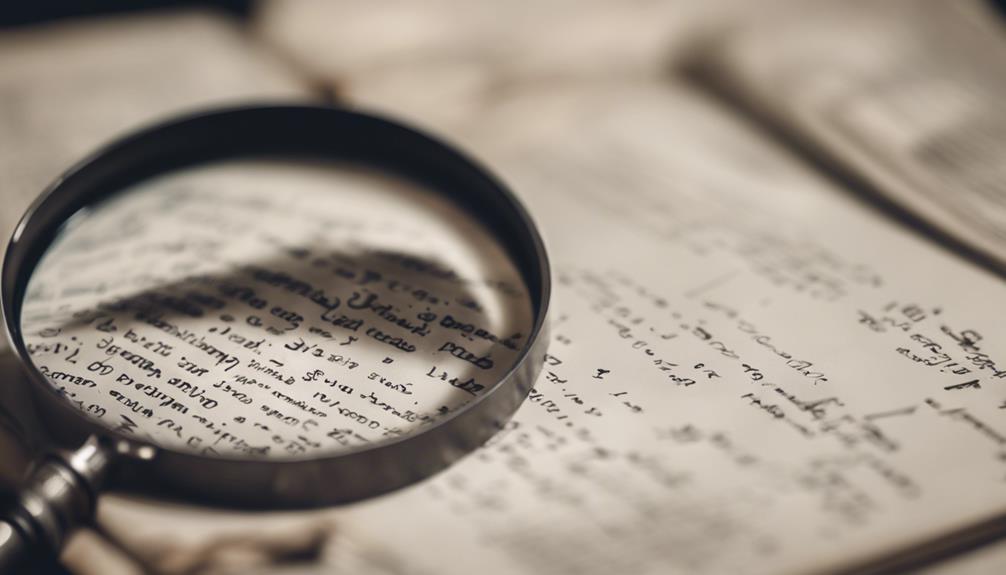Deciphering figurative language in poems is key to unraveling their depth. Figurative language, like similes and metaphors, conveys abstract ideas vividly. It elevates poetry by evoking emotions and creating rich imagery. Identifying literary devices such as personification and hyperbole enhances critical thinking skills. Analyzing figurative language reveals hidden meanings and thematic significance. Close examination uncovers layers of emotion and nuance within poetry. Understanding these elements enriches interpretation and appreciation of poetic expression. Each aspect adds unique layers to the tapestry of a poem's meaning.
Key Takeaways
- Identify similes, metaphors, and personification for deeper understanding.
- Consider context to grasp underlying meanings and themes.
- Look for patterns or repetitions of figurative language.
- Analyze imagery, symbolism, and allusion for nuanced interpretation.
- Decoding figurative language unveils the true essence and emotions of a poem.
Understanding Figurative Language Basics
Understanding the fundamentals of figurative language in poems is essential for appreciating the depth and artistry of poetic expression. Figurative language uses figures of speech like similes, metaphors, personification, hyperbole, and symbolism to convey abstract ideas beyond their literal meanings. When a poet employs figurative language, they create an extended metaphor, allowing readers to explore a world of deeper understanding and emotion.
In poetry, the use of figurative language elevates the text from mere words to a canvas of vivid imagery and profound meanings. By deciphering these figures of speech, readers can uncover the layers of symbolism and representation woven into the lines. This process not only enhances the emotional impact of the poem but also encourages critical thinking and interpretation skills.
Through poetry analysis, one can reveal the subtle nuances and hidden messages that lie beneath the surface of the words, providing a richer and more fulfilling experience for those who seek a mastery of the language of poetry.
Identifying Different Literary Devices

To explore the world of poetry analysis effectively, we must adeptly identify various literary devices that enrich the layers of meaning within poems.
Similes are comparisons using 'like' or 'as,' such as 'as brave as a lion.'
Metaphors directly compare two unlike things, like 'the world is a stage.'
Personification attributes human qualities to non-human entities, like 'the wind whispered secrets.'
Hyperboles are extreme exaggerations for emphasis, such as 'I've told you a million times.'
Symbolism involves using symbols to represent larger ideas, like a dove symbolizing peace.
By recognizing these literary devices, we can uncover the deeper meanings and emotions conveyed in poems. They serve to enhance the imagery and evoke strong feelings in the reader.
Mastering these tools allows us to appreciate the artistry behind the words and understand the poet's message on a more profound level.
Analyzing Figurative Language in Poetry

Delving into the intricate layers of figurative language in poetry reveals the hidden depths of emotion and meaning woven into the verses. Analyzing figurative language, such as similes, metaphors, and personification, is essential for unraveling the intricate tapestry of literary devices that poets employ. By understanding how figurative language influences the overall meaning and tone of a poem, readers can grasp the underlying messages and emotions conveyed by the poet.
Figurative language adds richness and complexity to poetry, enhancing the reader's experience by evoking vivid imagery and symbolism. Through recognizing patterns of imagery and symbolism, readers can uncover the thematic significance embedded in the figurative language of poems. Close reading and critical analysis play a pivotal role in decoding the nuanced meanings of figurative language, allowing readers to appreciate the artistry and depth of poetic expression.
In essence, figurative language serves as a gateway to the deeper layers of poetry, inviting readers to explore the profound depths of meaning, tone, imagery, and symbolism woven into the fabric of poetic verse.
Exploring Poetic Devices in Depth

Exploring the intricacies of poetic devices uncovers layers of meaning and depth within the domain of poetry. Poetic devices such as simile, metaphor, and personification serve as powerful tools to convey abstract ideas in a tangible way, allowing readers to connect on a deeper level with the text.
Understanding rhyme, alliteration, and onomatopoeia adds a musical quality to poems, enhancing the overall aesthetic experience. Recognizing the presence of repetition and symbolism in poetry helps unravel underlying themes and emotions, providing insight into the poet's intended message.
Analyzing how these poetic devices contribute to the structure and impact of a poem is essential for decoding figurative language effectively. By closely examining imagery, allusion, and connotation, readers can unravel hidden meanings and make connections that enrich their interpretation of the text.
Delving into the world of poetic devices not only enhances our appreciation of the art form but also sharpens our ability to engage with and interpret complex literary works.
Practical Application: Decoding a Poem

As we explore decoding a poem, we aim to identify and analyze the figurative language elements present to reveal deeper layers of meaning. When delving into a poem, we must pay close attention to similes, metaphors, and personification used by the poet. These elements go beyond literal interpretations, adding richness and depth to the text. By considering the context and underlying meanings of the figurative language employed, we can better understand how it enhances the imagery, emotions, and themes of the poem.
In our analysis, it's important to look for patterns or repetitions of figurative language. These repetitions often signify important themes or motifs that the poet wants to emphasize. By connecting the figurative language to the overall message or purpose of the poem, we can achieve a thorough understanding of the piece. Decoding the figurative language reveals the hidden treasures of a poem, unveiling its true essence and allowing us to appreciate the beauty of language and expression.
Frequently Asked Questions
How Do You Analyze Figurative Language in a Poem?
When we analyze figurative language in a poem, we explore the depths of its meaning and tone. By identifying similes, metaphors, and personification, we uncover the layers of imagery and emotion woven into the verses.
Looking for patterns and repeated instances reveals deeper themes, enhancing our understanding of the poet's intentions. Through this exploration, we decode the intricate web of language that adds richness and depth to the poem's message.
What Are the 5 Figurative Language in a Poem?
We identify five types of figurative language in poems: simile, metaphor, personification, hyperbole, and symbolism.
Similes compare using 'like' or 'as,' while metaphors directly link two things for deeper meanings. Personification gives human traits to non-humans, hyperbole exaggerates for emphasis, and symbolism employs symbols for larger ideas.
These techniques enhance poetic imagery and convey emotions in a more vivid, engaging manner.
What Is the Figurative Interpretation of the Poem?
When it comes to the figurative interpretation of a poem, we explore the layers of meaning beyond the literal words. By analyzing metaphors, similes, and personification, we uncover hidden messages and themes crafted by the poet.
This process enriches our understanding of the poet's creativity and intentions, allowing us to appreciate the vivid imagery and emotional impact of the language used. Decoding figurative language in poems lets us connect with the text on a deeper level.
How Do You Identify Figures of Speech in a Poem?
When identifying figures of speech in a poem, we look for comparisons like similes with words such as 'like' or 'as,' metaphors that directly compare unlike things, personification attributing human traits to non-human entities, hyperboles for exaggeration, and litotes for understatement.
Conclusion
To sum up, decoding figurative language in poems is like uncovering a hidden message within intricate layers of words. By grasping literary devices and analyzing poetic techniques, readers can reveal deeper meanings and emotions in the verses. Decoding figurative language allows readers to move beyond the literal interpretation of words and tap into the poet’s true intent. As they unpack metaphors, similes, and symbolism, they uncover nuanced perspectives that might otherwise remain concealed. In essence, decoding figurative language enriches the reading experience, transforming simple lines of text into a vibrant tapestry of meaning.
Just as a key reveals a treasure chest, decoding figurative language exposes the beauty and complexity of poetry.
So next time you read a poem, remember to explore beyond the words and dive into the rich symbolism that lies within.










